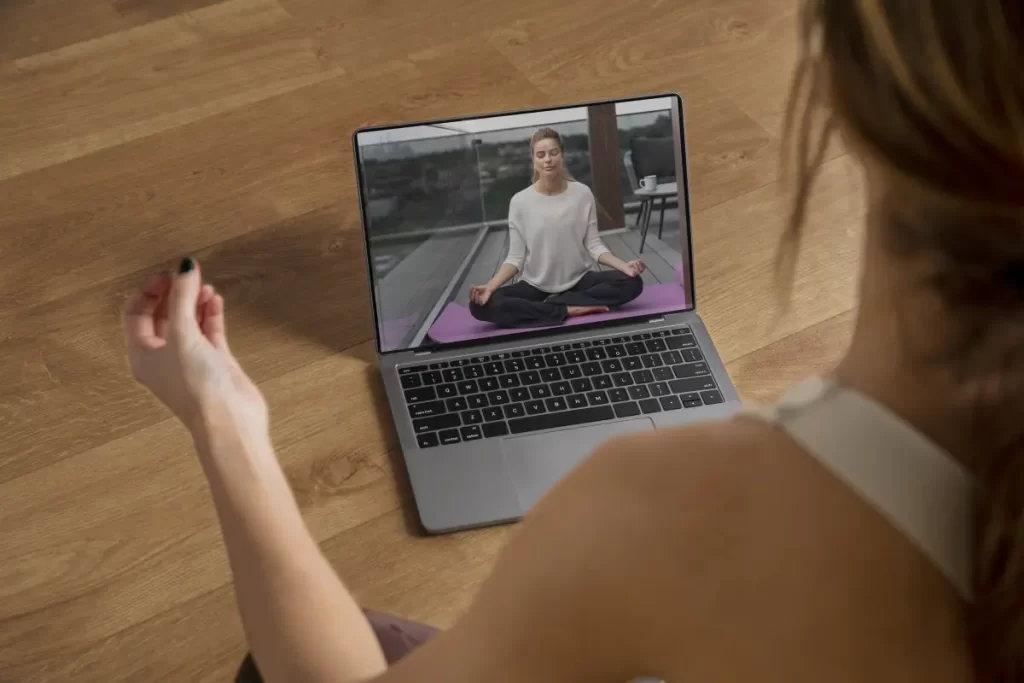Content:
- 1 1. Encourage Breaks and Movement to Protect Mental Health
- 2 2. Protect Time and Space to Support a Sustainable Work Rhythm
- 3 3. Foster open communication and emotional support
- 4 4. Build Trust Through Intentional Communication and Emotional Awareness
- 5 5. Strengthen Culture Through Consistent Social Connection
- 6 Supporting your team’s well-being
- 7 Frequently Asked Questions About Mental Health in Remote Teams
Remote work gives your team greater flexibility, but it also introduces new leadership responsibilities. When professional and personal boundaries begin to fade, the risk of burnout, disconnection, and performance drops becomes very real.
For founders and CEOs, mental health in remote teams should be treated as a core business priority. Supporting your team’s well-being leads to better focus, stronger collaboration, and greater long-term retention. It also reinforces the kind of culture top performers want to be part of.
Investing in mental well-being strengthens the core of your business. When people feel supported, they focus better, communicate more clearly, and bring steady energy to their work. A healthy remote team builds trust quickly, moves with clarity, and creates the kind of momentum that drives real growth.
The strategies below are designed to help you lead a healthier, more balanced remote team, one that stays sharp, engaged, and aligned as you scale.
1. Encourage Breaks and Movement to Protect Mental Health
In remote teams, physical stillness often leads to mental fatigue. Sitting for long hours without pause drains focus, increases stress, and reduces overall performance. Movement supports physical health, sharpens focus, and helps your team stay energized throughout the day.
Leaders should normalize short, frequent breaks throughout the workday. Even a five-minute walk or stretch between meetings can improve clarity, boost mood, and reset attention.
Physical activity helps reduce anxiety and supports overall well-being, especially in remote environments where the line between work and personal life can become blurred.
One effective approach is to launch a weekly step challenge or team movement goal. Ask employees to share progress in a dedicated Slack channel or leaderboard to build community around healthy habits.
You can also introduce “active breaks” during longer meetings, encouraging light stretches or posture resets that help combat the physical strain of desk work.
Providing tools like standing desks or recommending simple posture exercises can reinforce a culture of care and performance. These consistent practices help remote employees stay mentally sharp, physically energized, and better equipped to deliver their best work.
Need help building a healthier, more productive remote team? GlobalTeam’s Global Direct Hire™ service connects you with elite virtual professionals who maintain high performance while working in a rhythm that supports long-term well-being.

2. Protect Time and Space to Support a Sustainable Work Rhythm
The most effective remote teams have one thing in common: clear boundaries. Without them, the workday expands, stress builds, and performance suffers. Helping your team separate their work and personal lives is essential to protecting focus, energy, and long-term well-being.
Start by encouraging defined working hours, that might mean logging off at a set time each day, silencing notifications, or creating a personal routine that signals the end of the day, like shutting a laptop or going for a short walk. These cues help remote professionals reset and recharge.
When you lead by example and respect the same boundaries you set, by avoiding after-hours messages, honoring calendar blocks, and trusting your team’s time management, you create a culture where healthy work habits are clear, supported, and consistently reinforced. It also sets a cultural tone that values sustainable productivity over constant availability.
A designated workspace can make a powerful difference. This might be a full home office or simply a well-organized corner of a room, but having a consistent place to work helps reinforce the mental shift between being on the clock and off.This is especially important for team members managing caregiving or household duties during the day.
Flexibility is part of the advantage of remote work, use it to your team’s benefit. Offering a few adjustable hours or asynchronous working options can help employees maintain balance while still delivering results.

3. Foster open communication and emotional support
Open communication is a cornerstone of a healthy remote work environment. Remote employees can feel isolated and disconnected from their colleagues, which can lead to stress, anxiety, and decreased job satisfaction.
Fostering open lines of communication, where employees feel safe expressing their concerns or challenges, can make a big difference in their mental health.
To facilitate this, implement regular check-ins with each team member. These should be more than just status updates on work tasks; ask how they’re feeling and whether they need any support. Managers can use tools like anonymous surveys to assess the overall well-being of the team, allowing employees to voice concerns without fear of judgment.
Another useful practice is creating a peer support system, where team members are encouraged to check in on one another.
Building an environment where empathy and emotional intelligence are prioritized helps normalize conversations around mental health, making employees feel valued beyond their work performance.
Offering resources such as access to mental health professionals, wellness apps, or mindfulness programs can also give employees practical tools to manage stress.
Additionally, providing mental health training for managers can empower them to recognize signs of burnout or emotional distress in their team.
Equipping leaders with the knowledge to support employees more effectively will contribute to a more compassionate and understanding work culture.

4. Build Trust Through Intentional Communication and Emotional Awareness
Burnout and mental fatigue are real risks for remote workers who feel they need to constantly be available or productive. Encouraging the use of mental health days and offering flexible schedules can help alleviate this pressure.
Allowing employees the flexibility to structure their day in a way that best fits their individual needs can significantly reduce stress.
For instance, offering a “no questions asked” mental health day policy can be a powerful tool in promoting employee well-being. These days give team members the freedom to step away from work to rest, recharge, or simply take care of their emotional needs without feeling guilty.
Similarly, you could implement “well-being days” or half-days where employees are encouraged to engage in activities that help them relax or pursue hobbies outside of work.
Flexible scheduling is another key to supporting mental health. Different employees may be more productive at different times of the day, and accommodating this can lead to better results and higher job satisfaction. Some may prefer to work early in the morning, while others may be more focused in the evening.
Giving them the flexibility to create their own schedule, as long as they meet deadlines and stay engaged, helps reduce the pressure of maintaining a strict 9-to-5 routine.

5. Strengthen Culture Through Consistent Social Connection
Connection drives performance. In remote teams, where casual conversations and spontaneous interactions don’t happen by default, building a strong sense of belonging takes intention. When people feel connected to their colleagues, they collaborate more effectively, stay engaged longer, and bring more energy to their work.
Encourage moments that create shared experience beyond project work. Virtual coffee chats, casual Slack threads, or end-of-week team check-ins create space for light conversation and genuine connection.
You can also invite team members to share personal highlights, photos of a weekend trip, a favorite playlist, or snapshots of their home workspace. These touchpoints add warmth to the virtual environment.
Go a step further with optional team-building activities. Think cooking classes, group workouts, themed quizzes, or cause-driven initiatives like virtual fundraisers. These shared experiences give people something to look forward to and build trust that carries into everyday collaboration.
Celebrating personal wins matters too. Acknowledging birthdays, anniversaries, or key milestones reinforces that your culture values people, not just performance. The more your team feels like a community, the more resilient and motivated it becomes.

Supporting your team’s well-being
Remote teams work best when they feel focused, energized, and connected. Prioritizing mental well-being creates the conditions for better collaboration, stronger results, and lasting engagement.
As a founder, the culture you build starts with the choices you make each day. Encouraging healthy routines, supporting flexible work rhythms, opening space for honest communication, and creating opportunities for connection helps your team grow with consistency and care.
The Global Hiring System™ is designed to help you hire top-tier talent and build the kind of remote team that performs at a high level while staying grounded, balanced, and aligned with your values.If you’re ready to take the next step, book your free consult and discover how GlobalTeam can support your growth. Book your free consultation here.
Frequently Asked Questions About Mental Health in Remote Teams
Why is mental health important for remote teams?
Mental health directly impacts focus, productivity, and team engagement. In remote settings, where isolation can increase, supporting well-being is essential to maintaining performance and long-term retention.
How can leaders support mental health without overstepping?
Start with structure—clear expectations, flexible schedules, and consistent communication. Ask open-ended questions, respect boundaries, and offer access to wellness resources without pressure.
What are signs a remote employee may be struggling?
Look for sudden changes in communication style, missed deadlines, or reduced engagement in meetings. These may be early signals that someone needs extra support.
Do mental health initiatives actually improve productivity?
Yes. Studies show that well-supported teams are more focused, creative, and resilient. Simple habits like regular breaks and team connection activities lead to measurable gains in output.
What tools can help support mental health remotely?
Popular tools include Slack for daily check-ins, Headspace or Calm for mindfulness, and platforms like Kona or Officevibe for tracking team well-being trends.

